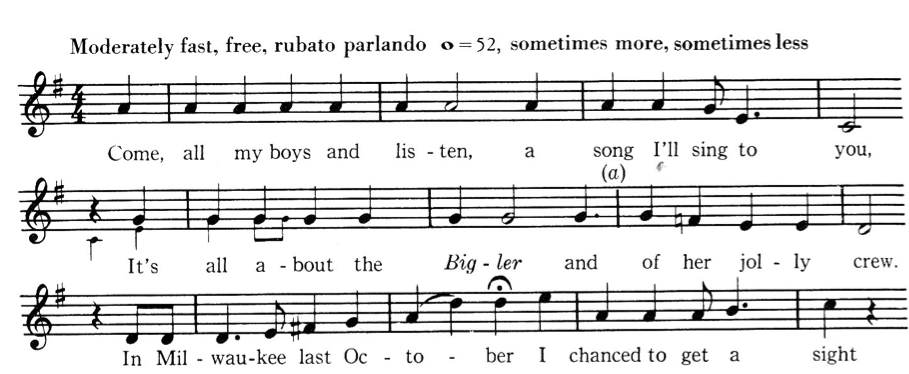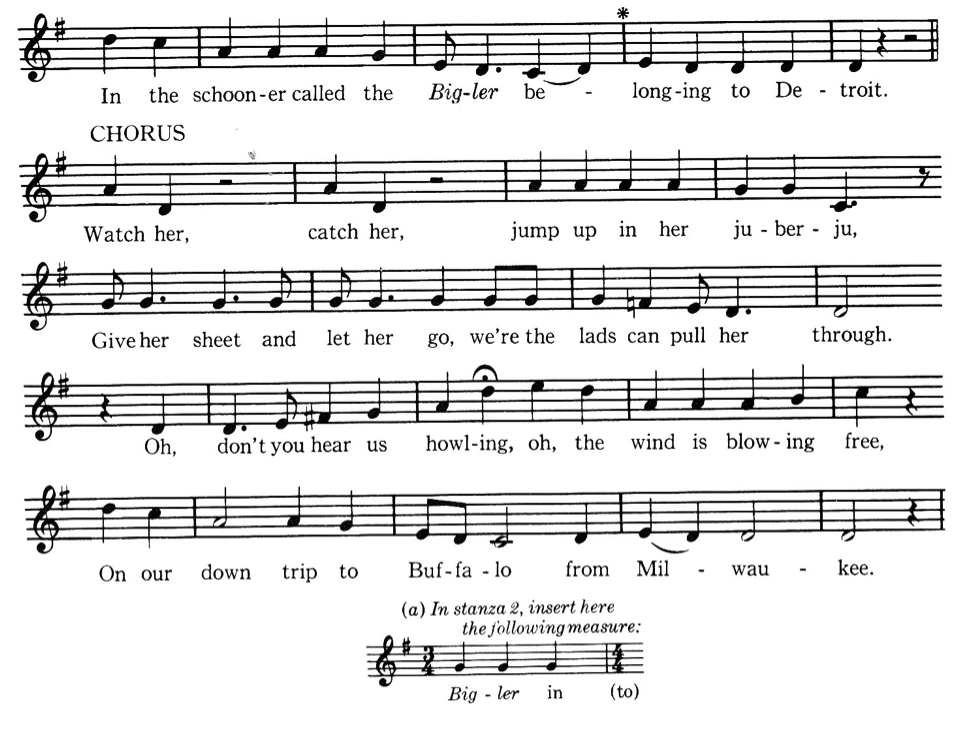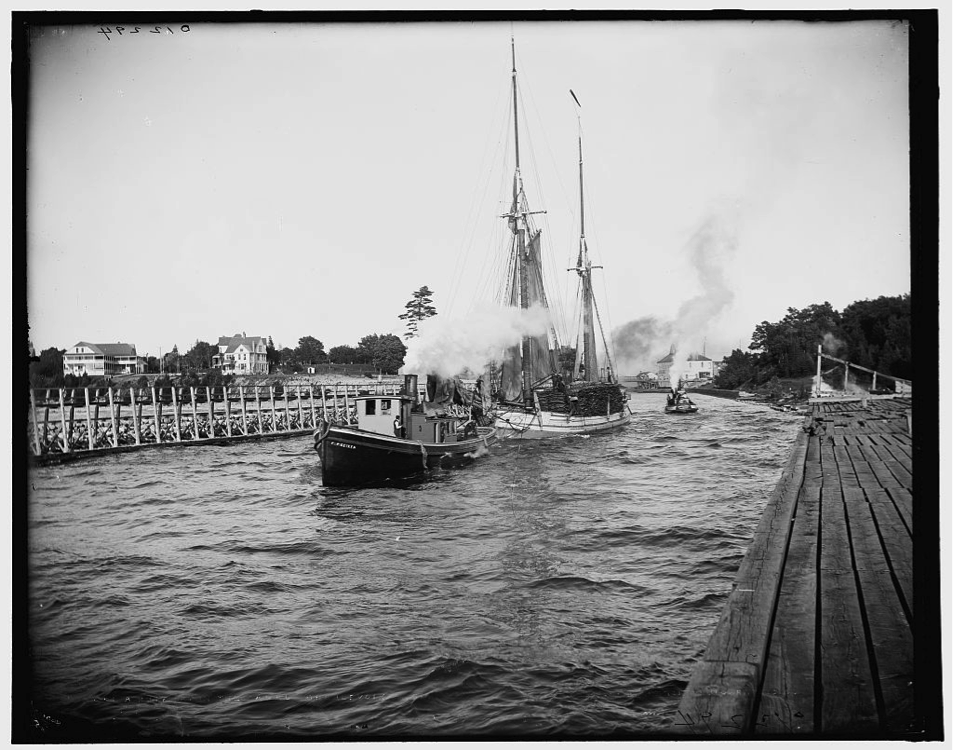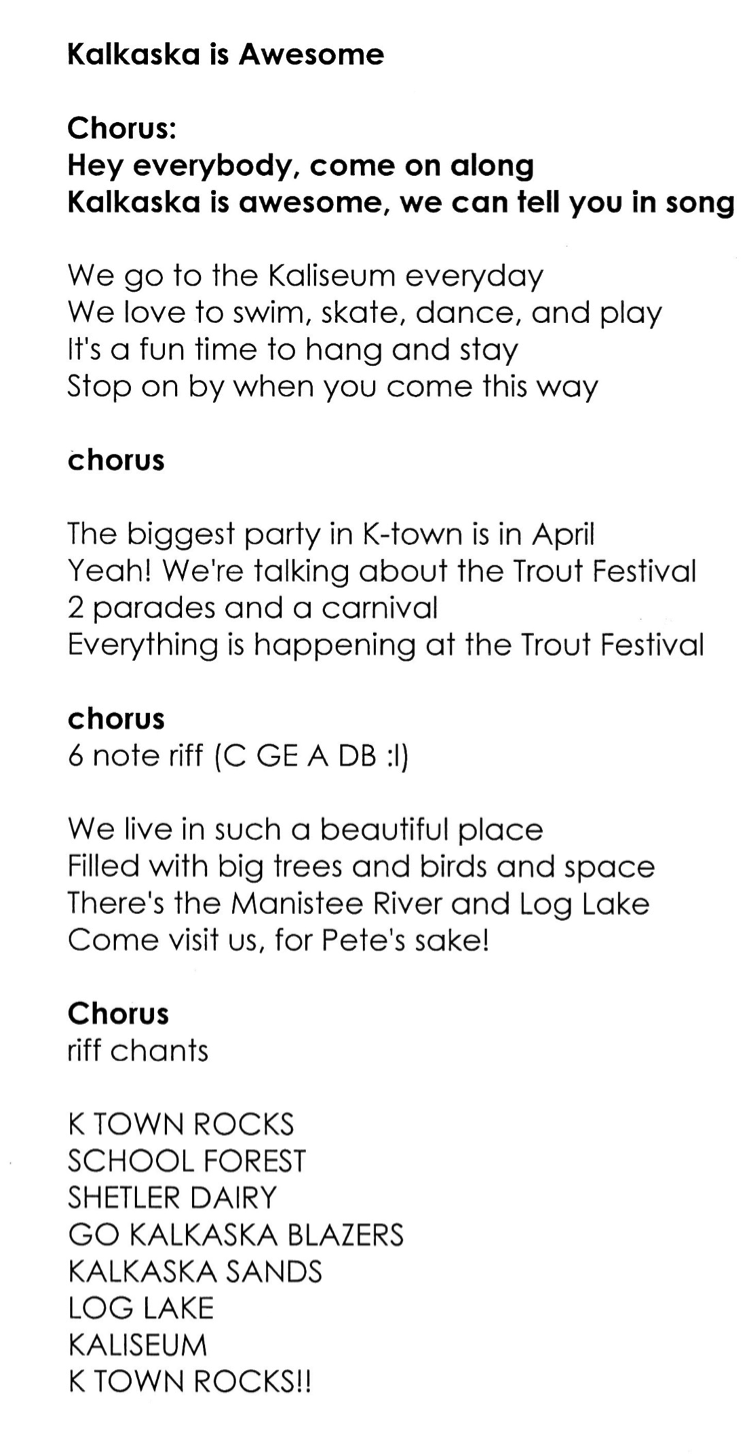"The Bigler": Take a Musical Tour with a Great Lakes Schoonerman
Grades: 6-8, 9-12
Selections:
Kalkaska is Awesome" (video)
Recorded: Charles, Michigan, September, 1938; Traverse City, Michigan, May 9, 2014
Performers: Asel Trueblood, Kalkaska (Michigan) Middle and High School students
Activity 1: Songs of the Schoonermen
- Teacher provides some background to Great Lakes, sailors, and their ballads (songs that tell a story).
- The 1860s-1880s were the golden age of schooners on the Great Lakes, when they were an essential part of the region’s economy
- During this period as many as 1800 schooners sailed the lakes, carrying cargos of grain, lumber, and ore
- Trips between Great Lakes ports ranged from overnight to several weeks, depending on the weather
- Sailors on these vessels—called schoonermen—developed stories and songs about their distinctive occupation.
- The songs were sung for their own amusement during the long trips up and down the lakes, or in port-side saloons. A sailor who could sing never had to buy his own drink!
- Teacher prepares students to listen to “The Bigler” by providing the following background (provided by folklorist Ivan Lomax for the publication Our Singing Country by John and Alan Lomax):
- This is the best-known song that came out of the lumber trade on the Lakes
- The song uses sailor jargon, or special terms known to this occupation
- The song traces the journey of the Bigler, naming places that were well-known to the Great Lakes schoonermen
- The schooner Bigler, which was evidently carrying a cargo of grain on the trip narrated in the song, was a blunt-nosed scow that was slow and hard to steer.
- The ‘juberju’ mentioned in the song has been variously described as the jib boom, the raffee yard, and the crossfire, upon which the sailors at times climbed to ride the halyard down to the deck.
- Students listen to “The Bigler.” *Note, Verses 2, 3, 4, sung by Asel Trueblood of Charles, Michigan (near St. Ignace). Other verses (in written form only) from R.F. Hasbrook, Bessemer, Michigan. Students may read or sing the remaining verses. In Trueblood’s time, a single sailor often sang the verse, while his mates joined in on the chorus.


Transcription of “The Bigler” from Our Singing Country. “The Timber Drogher Bigler”
[*Verses 2, 3, 4, shown in italics, sung by Asel Trueblood of Charles, Michigan (near St. Ignace). Other verses from R.F. Hasbrook, Bessemer, Michigan.]Come, all my boys and listen, a song I’ll sing to you,
It’s all about the Bigler and of her joy crew.
In Milwaukee last October, I chanced to get a sight
In the schooner called the Bigler belonging to Detroit.Chorus: Watch her, catch her, jump up in her juberju,
Giver her sheet and let her go, we’re the lads will pull her through.
Oh, don’t you hear us howling, oh, the wind is blowing free,
On our down trip to Buffalo from Milwaukee.It was on a Sunday morning just at the hour of ten,
When the tug Nickle Roberts towed the schooner Bigler into Lake Michigan,
Oh, there we made our canvas, in the middle of the fleet,
Oh the wind hauled to the south’ard, boys, and we had to give her sheet.Chorus
The wind come down from the south-southeast, it blowed both stiff and strong,
You’d ought seen that little schooner Bigler as she plowed out Lake Michigan,
Oh, far beyond her foaming bows the fiery waves to fling
With every stitch of canvas and her course was wing and wing.Chorus
Passing by the Foxes, the wind was blowing free
Sailing by the Beavers with the Skilagalee on our lee
Oh, we hauled her in pulling, boys, as close as she would lie,
We weathered Wabbleshanks and entered the Straights of MackinacFirst Forty-Mile Point and Presque Isle Light and then we boomed away,
The wind being fresh and fair, for the Isle of Thunder Bay.
The wind it shifted to a close haul, all on her starboard tack,
With a good lookout ahead we made for Point aux Barques.We made the light and kept in sight of Michigan’s east shore,
A-booming for the river as we’d often done before.
And when abreast Port Huron Light, our small anchor we let go;
The tug Kate Moffet came along and took the Bigler in tow.The Moffet took six schooners in tow, and all of us fore-and-aft,
She took us down to Lake St. Clair and stuck us on the Flats,
She parted the Hunter’s towline in trying to give relief,
And stern to stern went the Bigler smash in the Mapleleaf.Then she towed us through and left us outside the river light,
Lake Erie for us to wander and the blustering winds to fight.
The wind was from the sou’west, and we paddled our own canoe,
Her jib boom pointed the **Dummy, she’s hell-bent for Buffalo.Dummy: likely another word for decorative figurehead at the bow of the vessel
Haul: To steer (a vessel) closer to the direction of the wind
Jib: triangular sail at the front of the ship
Boom: A spar attached to the foot of a fore-and-aft sail. - Students receive further background by reading (or listening to the teacher read) what the singer--former schooner captain, Asel Trueblood—had to say about the song (as told to Alan Lomax):
“I learned this song a good fifty years ago. I was twenty-three at the time. I’ve walked the old Bigler’s decks many times though I never sailed on her. She was supposed to be the slowest vessel in the fleet, and, of course, they had winds and all that and she’d bile along like everything but the other vessels would beat her. They stopped many places on the way down, and a new verse was composed about every place they stopped in and every place they’d pass. And when they got done in Lake Erie, before they got to Buffalo, they met the fleet coming back.
I knew this feller that composed this song about the Bigler, but I forgot his name. It was a kind of a jokey song like, because they got beat. He said they’d a’beat the fleet if the fleet had a’hove to. The places they stopped in were the whorehouses on the way down, and they’d get in there drinkin’ beer and singin’ this song, and it bought ‘em a lot of free beers.”- Students identify terms and other features from the ballad in the photo of a wooden two-masted timber schooner, c. 1900, leaving the channel at Charlevoix. Click here for a high resolution version that will enable more detailed viewing and zoom functions. (**Note, the Bigler, known as a “scow-schooner,” would have been a different shape, with a wider hull and a square bow and stern.)
- Tug and towline
- Canvas (sails)
- Sailors—how many can you find?
- Starboard (right side of vessel)
- Stern (rear of vessel)
- Boom (large pole attached to bottom of sail)
For high resolution viewing with zoom capability:
- Cargo (sheets of bark)
- Sailors—how many can you find?
- Clothing worn by sailors
- Cargo (sheets of bark)
- Name of vessel (Annie O. Hanson, built 1869 in DePere, WI; foundered off Manistee on March 30, 1902, when she was driven ashore by ice flows during an early season run to take advantage of high prices for her cargo. No hands were lost.)

Timber schooner leaving the channel at Charlevoix, Michigan, 1900. “The Bigler” was a timber drogher, a ship specially built to carry squared logs. Photo from Detroit Publishing Company Collection, Library of Congress. http://www.loc.gov/pictures/item/det1994005446/PP/
Activity 2: Chart the Voyage of "The Bigler"
- Students track the voyage of the Bigler from Milwaukee to Buffalo on a map of the Great Lakes with sufficient detail so geographic features and ports can be located. Note: the website for Brian Miller and Randy Gosa, Traditional Music from the Northwoods Music, includes an online interactive map of the Bigler’s route, based on a different version of the ballad, sung in 1922 by Minnesota singer Michael Dean. See http://www.evergreentrad.com/the-biglers-crew/...
- Students select a place on the trip to research and report to the class. Enhance the map of the Bigler’s route with captions and/or photos to display as a class exhibit. Places include lakes, ports, islands, lighthouses, the Straights of Mackinac. Modern day marine preserves involving historic shipwrecks of the period include the Manitou Passage Underwater Preserve (part of Sleeping Bear Dunes National Lakeshore) (http://www.michiganpreserves.org/) and the Thunder Bay Marine Sanctuary (http://thunderbay.noaa.gov/).
Activity 3: Take a Musical Tour of Your Community
- 1. Teacher points out the formulaic opening of "The Bigler"—"Come, all my boys and listen, a song I’ll sing to you." Many traditional ballads open with a version of the "come all ye" formula. **See, for example, in other Michigan lessons "The Gallagher Boys" and "Once More A-Lumbering Go."
- 2. Students watch/listen to "Kalkaska is Awesome," a collaboratively written song by Kalkaska, Michigan area students in 2014, and inspired by "Come all ye" ballads collected by Lomax in Michigan. Kalkaska students updated their opening to "Hey, everybody, come on along; Kalkaska is awesome, we can tell you in song." Like "The Bigler," this student-written song celebrates and lists local places of importance to the singers, taking listeners on a musical tour of their town. Notice how, at the end of "Kalkaska is Awesome" the performers shout out important places in their town than are meaningful to them.
Q—What are the special places in your town, county, community, region? - Students write a collaborative song, modeled on "Kalkaska is Awesome" about important places if someone were to take a musical tour of "their place." Use "The Bigler" as the structure for the new song, substituting your own community, neighborhood, school, etc. as the focus. The chorus can easily be adapted to your place, with new verses added.
**Note: Kalkaska-area students created this song as part of the Quest-A Celebration of Community 2014 [http://earthworkmusic.com/quest2014/], an innovative, place-based after school arts program in seven underserved schools in northwest Lower Michigan. The grand finale concert, held in May 9 2014, featured students’ artwork and collaboratively written songs, inspired by Lomax’s 1938 Michigan recordings. The Quest is a program of SEEDS, a Traverse City, Michigan non-profit. For more discussion about the Quest, and how it became the basis of a semester-long project, see the Laurie Kay Sommers and Samuel Seth Bernard, "Questing with Lomax: Michigan’s Historic Field Recordings Inspire a New Generation," Journal of Folklore and Education Vol. 2 (2015).
Collaborative Songwriting Template (courtesy of Seth Bernard, Artistic Director of The Quest, Traverse City, Michigan)
Phase 1 Brainstorming and free association, ideally with a circle of 5 to 20 people. Participants each contribute a word or sentence that is then written down by the facilitator. After one round, everyone closes their eyes, and the facilitator recites the ideas of the group. Everyone listens to the sounds of the words and creates mental pictures of the words and phrases. Another round of brainstorming is shaped by the first round of words. Some words and phrases connect. Some may be another phrase that rhymes. [**For "The Bigler," the facilitator may want to prompt ideas about the students’ favorite or important places on the tour. Certain melodies may emerge. [**With "The Bigler" or another pre-existing song as inspiration, you already have a melody to work with.] A large group may only have to go around twice.
Phase 2 Facilitator asks about connections of words and phrases: Is a story or form emerging? Is a chorus emerging? Sometimes students will already have melodic ideas. Find rhythms of words and musical motifs that go with that. [**For "The Bigler," consider using the existing rhyme scheme: AABB]. Employ democracy and give everyone’s idea a chance, it works every time.
Phase 3 Work out verses, choruses, bridge, or riff.
**With "The Bigler" existing music and melodic ideas can serve as a springboard for content. Or, simply use the entire tune. Alternatively, use the updated 2014 version, "Kalkaska is Awesome."
Phase 4 Perform and record the song using a smart phone or a recording engineer. Do at least two takes of a song, creating a professional environment. Re-work the song as needed. Emphasize that everyone has a role.
Phase 5 Give a public community performance.
"Kalkaska is Awesome" lyrics by Kalkaska High School and Middle School students participating in the Quest 2014, a program of SEEDS of Traverse City, sponsor for the Quest Project. SEEDS is a 501(c)3 nonprofit organization established to foster local solutions to global issues.
Extensions:
Explore the Great Lakes further—history, economy, geography, geology, biology, etc. Compare/contrast the Lakes of the 1880s with the Lakes of today. Good online resources include Michigan Sea Grant’s Teaching Great Lakes Science, Lessons and Data Sets http://www.miseagrant.umich.edu/lessons/. Lake Rhymes, Folksongs of the Great Lakes Region, A songbook and study guide with an 18-song companion (Lee and Joann Murdock, 2004) is an excellent resources for educators.
Explore other schoonermen songs in the Lomax collection online. Not all songs were about vessels and sailing. What did the schoonermen sing about? Search the repertoire of Asel Trueblood and John W. Green in the Alan Lomax Collection of Michigan and Wisconsin Recordings, www.loc.gov/collection/alan-lomax-in-michigan/about-this-collection/ . Also see Windjammers (Walton and Grimm) listed below in credits.
Credits:
John A. Lomax and Alan Lomax, compilers. Our Singing Country, Folk Songs and Ballads (1941, 1968)
Ivan Walton and Joe Grimm, Windjammers, Songs of the Great Lakes Sailors (Detroit: Wayne State University Press, 2002).
"Hanson, Annie O." Bowling Green State University Great Lakes Vessel Online Index, http://greatlakes.bgsu.edu/vessel/view/003893
Information on the Annie O. Hanson adapted from Dave Swayze, The Great Lakes Shipwreck File: Total Losses of Great Lakes Ships 1679 – 1999, http://www.boatnerd.com/swayze/shipwreck/
Special thanks to Seth Bernard, Artistic Director of the Quest and source of the collaborative songwriting template, and to SEEDS of Traverse City, sponsor for the Quest Project. SEEDS is a 501(c)3 nonprofit organization established to foster local solutions to global issues.
For a more in-depth look at the Quest Project with samples of student work and other ideas based on the 1938 Lomax material, see Laurie Kay Sommers and Samuel Seth Bernard, "Questing with Alan Lomax: Michigan’s Historic Field Recordings Inspire a New Generation." Journal of Folklore and Education (2015 Vol 2): 51-62. http://locallearningnetwork.org/guest-artist/journal/
Lesson Plan by Laurie Sommers
With generous support from the NEA
